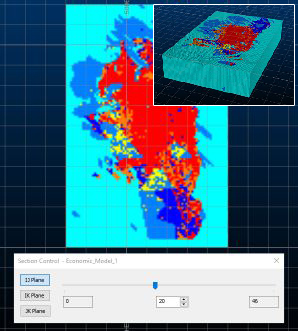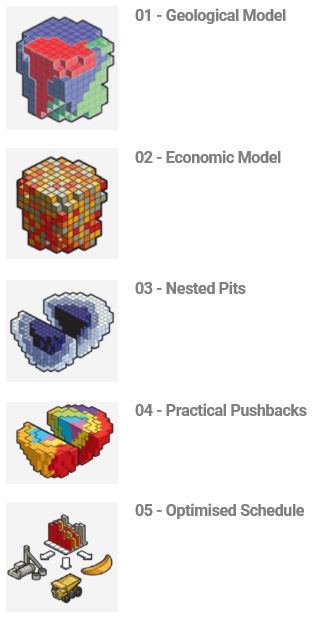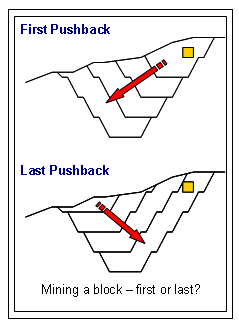Studio NPVS
Generating the optimal strategic plan for an open pit operation requires solving complex mathematical problems which are bound by various constraints such as:
-
the geological realities of the ore body (e.g. grade distribution, contaminants, etc)
-
The economic conditions for mining, e.g. mining and processing costs, commodity value, discount rate, capital costs
-
The engineering requirements for pit slope, dilution, processing recovery, minimum mining width, truck fleet, material destinations, etc.
Studio NPVS addresses these constraints to produce a viable and practical strategic mine plan. It includes a managed workflow and database for pit optimization, pushback design, scheduling, stockpiling and cutoff grade optimization.
The goal of any mine scheduling operation is to clearly define a sequence of events that will, when applied to a real-world mining scenario, generate the highest possible Net Present Value (NPV) over the life of the mine

Economic model shown as a section and 3D blocks
To optimize a strategic mine plan for maximum NPV requires the simultaneous resolution of two concepts that, on the face of it, are in conflict with each other, namely, the design of the mine and the schedule of that design. The tension between design and schedule creates what appears to be an unsolvable problem: when is the optimal time to mine a discrete block of ore if the time it is to be mined depends on its value - and yet the value depends on when it is to be mined? Studio NPVS uses a unique and sophisticated methodology to resolve this situation in a practical way.

A schematic outlining the key phases of the Studio NPVS workflow
In summary, an effective schedule must balance the value of commodities that can be mined (in a practical sense, taking all mining considerations into account, including processing costs, maintaining mine safety, limits imposed by subsequent operations etc.) against the costs of doing so. The way resources are mined, meaning the how, where and (just as importantly) when they are transformed into a reserve, has a crucial impact on the viability of mining operations. Effective control over the scheduling of mining and subsequent processing and distribution of commodities will determine how successful an operation is (i.e. how high a level of NPV can be obtained) over the feasible life of the mine.
Who Uses Studio NPVS?
-
Resource geologists and other practitioners that need to constrain a resource with economic pit (RPEEE).
-
Senior mining engineers / managers at corporate office for due diligence, acquisitions, PFS, FS, trade off studies, and so on.
-
Mining engineers and managers at mine sites for reserve updates, LOM plans, trade off studies and more.
-
Technical consultants.
Why 'When' Is Important...
Early pit optimization methods took no account of the time value of money as they were based on the non-discounted cashflow from the pit.
The concept of discounting is important. It makes commercially viable sense to generate as much return as possible, in as short a space of time as possible, and this is the case in most business scenarios. Mining is no exception, particularly so in the mining of precious and semi-precious products. The rule of thumb is that, where possible (meaning, profitable) the highest possible grade of a product should be mined at as early as stage as possible. In this situation, reserves are realized up front, and providing a better economic condition in which to continue generating more revenue. As a more practical example, if Au has a value of, say $350 an ounce today, there is no guarantee that this will be the case in 5 years time, when the deeper regions of a pit are being explored.
The concept of discounting takes things a step further; the realization of reserves (which in the sense of scheduling, equates to a value in $ terms) is the overall aim. It is this value today that is important. Even if the price of the commodity in question remains consistent throughout the entire life of the mine, the $ acquired from the mining of a commodity mined today would almost certainly be worth less in the future (if you had $10 today, it would have more spending power than in 10 years time). Discounting is the process by which this effect is compensated for in advance.
Bearing this in mind, block (a finite, measured volume of orebody) values must be discounted first in order to calculate the ultimate pit (otherwise, mining operations would become less and less profitable over the life of the mine - with each identical and subsequent phase generating less value in real terms) but at the early stage of pit analysis mine schedulers will have no idea of the sequence in which the blocks will be extracted and therefore no precise way of determining by how much the value should be discounted.
Take, for example, a waste block at the surface near the pit rim, as shown in the diagram below:

The highlighted block might be mined early as part of the first pit or later during pre-stripping of the last pushback – perhaps a difference in scheduling of 20 years. This difference makes it very difficult to determine the discount for that specific block and hence its value in the project.
The Discounting Problem
Your product resolves the issue of how to discount a block by determining the extraction sequence that derives the highest theoretical NPV. This is called the Optimal Extraction Sequence (OES) and Studio NPVS enables the engineer to use the OES to create a workable mine plan by successively adding the effects of mining constraints to produce practical mine designs and achievable mining schedules. These constraints penalize the theoretical maximum NPV but drive toward a practical solution with optimal NPV under the given mining conditions. As constraints are progressively added at each stage of optimization a revised OES is calculated.
NPV and the Optimal Extraction Sequence
In order to derive the highest theoretical NPV (in a reasonable time frame) Studio NPVS takes the approach of categorizing large domains of the deposit from the most valuable to the least valuable with the intention of mining them generally in that sequence. This is consistent with the principle of scheduling the highest value first to create the highest overall NPV. Your product then successively re-categorizes smaller domains within those larger categories using practical mining constraints to arrive at a result that is a practical mine plan with the highest possible NPV.
It should be noted here that there are situations where the maximum NPV is not necessarily the optimal objective, particularly in industrial mineral deposits where the inherent value of the commodity itself is not the main consideration. The optimal strategic plan for a limestone mine is driven by fundamentally different factors than the optimal plan for a gold mine, for example, because limestone has little intrinsic value. A large reserve of limestone, however, that can be mined to “tight” quality specifications (particularly low contaminant levels) is of substantial value.
Your product can optimize the strategic plan to other planning constraints such as maximum resource life, stability of product specification, minimization of contaminants, stability of the feed to the mill, etc. Therefore, your product is equally capable of deriving optimal plans for industrial minerals as it is for base or precious metal deposits.
Your product follows a practical approach to the generation of the OES. Each of the items in the list below is a link to a separate conceptual topic that discusses how each particular step of the operation is approached in order to ensure a consistent workflow, generating the maximum return:
-
Define the Economic Model for the life-of-mine scenario. The economic model is defined by setting cost and price parameters for the life of the mine and then calculating an intrinsic value per processing method of each block in a geological block model as a function of its geometallurgical attributes.
See The Economic Model.
-
Create a series of nested pit shells, often referred to as Phases, which represent a set of Ultimate Pits for the varying economic parameters.
See Nested Pits.
-
Use the pit shells (Phases) to determine the Ultimate Pit OES for the nested pits. See Ultimate Pit OES.
-
Use the Ultimate Pit Optimal Extraction Sequence and the LG Pits to determine the practical mining Pushbacks and the Pushback OES (a refined sequence taking practical aspects into account) in which each block is assigned its pushback number.
See Pushbacks.
-
Schedule the Pushbacks to meet production targets and mining constraints, and then use these results to iteratively refine the pushback generation parameters. Each block is assigned a time period number in the resulting Schedule OES.
Optional Software Modules
Additional software modules allow this process to become even further refined for specific situations:
-
Use the Mine Flow Optimizer to determine whether further gains in NPV can be achieved by accelerating mining rates to extract higher grade ore sooner for processing and as a result discarding or stockpiling lower grade ore for later processing. See Mine Flow Optimizer.
-
For industrial mineral type deposits use the Material Allocation Optimizer to optimize the destinations to which blocks must be sent to meet targets for multiple blended products when using multiple processing methods. See Material Flow Optimizer.
-
For projects in which conditionally simulated block models are available Geological Risk Analysis can be used to assess the risk of the mine plan associated with the inherent uncertainty in the geological model. See Geological Risk Analysis.

